Rasam and rice is our favorite meal combination. With my South Indian roots, a rasam-rice combination is always a comforting meal. So, a rasam is one of those dishes that I often make at home. This Garlic Rasam, regionally known as Poondu Rasam is one of the variations I prepare. It is a spicy, tangy rasam with a tempering of garlic, herbs and spices.
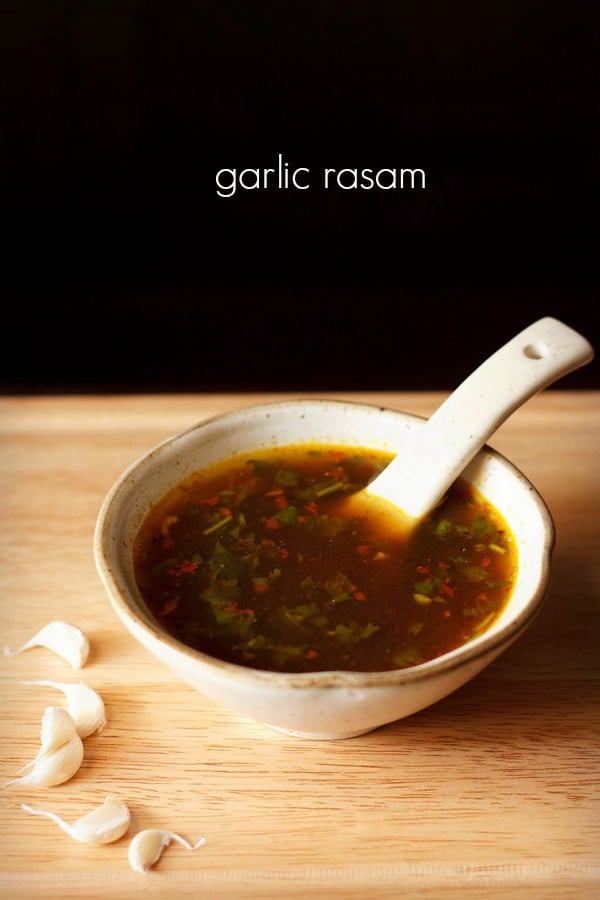
About Garlic Rasam
The Garlic Rasam is one of the popular rasam variations in South India. This hot and garlicky version is traditionally named as Poondu Rasam in the cuisine of Tamil Nadu. Obviously, as ‘garlic’ is referred to as ‘poondu or puntu’ in Tamil language.
A classic Rasam is primarily a thin and clearish soup like preparation, made in a South Indian style. The primary ingredients that form a part of any rasam are usually spices, some lentils, tomato and tamarind. The use of tamarind gives a rasam the significant tang.
The same goes for this Poondu Rasam too. One of the primary ingredients in this recipe is also tamarind, the pulp of which is added to the liquid base for the typical flavor.
In addition to this, other ingredients that are added in this Garlic Rasam are of course garlic, black pepper, cumin seeds, dried red chilies, mustard seeds, urad dal, curry leaves, tomatoes, turmeric powder, asafoetida (hing) and coriander leaves.
Like I mentioned earlier, there’s a tamarind pulp which is added in the recipe. I prefer making my own tamarind pulp at home by soaking seedless tamarind in hot water and then squeezing out the extract into the water.
If you don’t have time, you can even use readymade tamarind pulp. In that case, beware of the quantity as you don’t want your Poondu Rasam to become extremely sour.
I also use sesame oil for the tempering of this Garlic Rasam. In case you don’t have this particular oil, you can use any neutral flavored oil for this rasam recipe.
I make this Poondu Rasam as well as many other varieties of rasams on a regular basis. Especially, when the weather is rainy or during the cold winter season, rasams are a hot favorite with everyone at my home.
This Garlic Rasam or any other rasam is a great home remedy for treating coughs and colds. So, a rasam is a default choice for such days too. I also make rasam on those days, when I want to make a quick, spicy and an easy dish with rice.
This Poondu Rasam does not make use of the readymade rasam powder and cooked dal (lentils). The coarsely ground spice mixture that is a part of this recipe is what is there in the dish, in place of the rasam powder.
With this Garlic Rasam, I usually serve steamed rice, a veggie roast or any veggie poriyal like Carrot Poriyal or Beetroot Poriyal. But both steamed rice and rasam is such a comforting meal, that you may not need to have any side dish. You can even drink it plain like a soup.
How to make Garlic Rasam
Make Tamarind Pulp
1. Heat ½ cup water and soak 1 tablespoon tightly packed seedless tamarind in it. Cover and keep aside for 20 minutes.
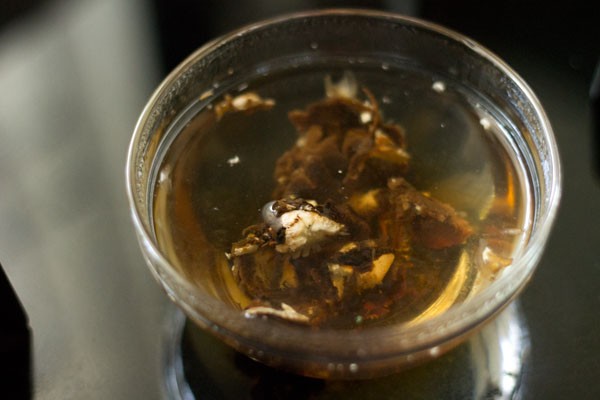
2. After 20 minutes, squeeze the softened tamarind very well in the water. Keep this tamarind pulp aside.
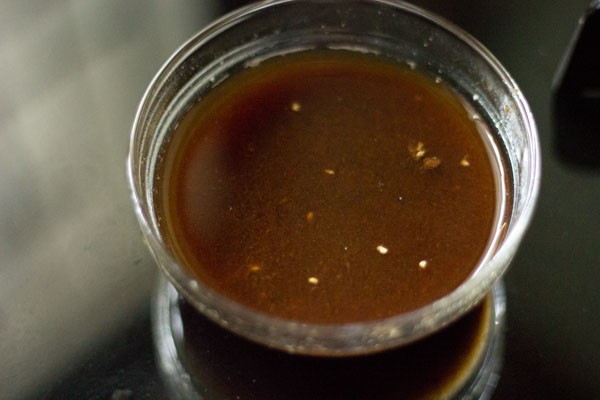
Make Rasam Spice Mixture
3. While the tamarind is soaking, add 1 teaspoon black peppercorns, 1 teaspoon cumin seeds, 2 to 3 peeled garlic cloves and 2 dried red chilies (broken and deseeded) in a small dry grinder or spice grinder.
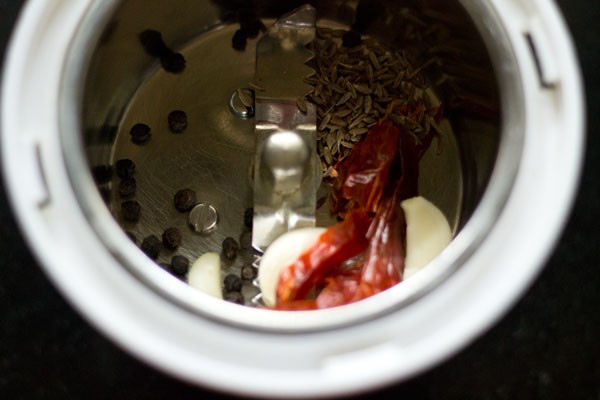
4. Grind to a coarse mixture. Keep aside.
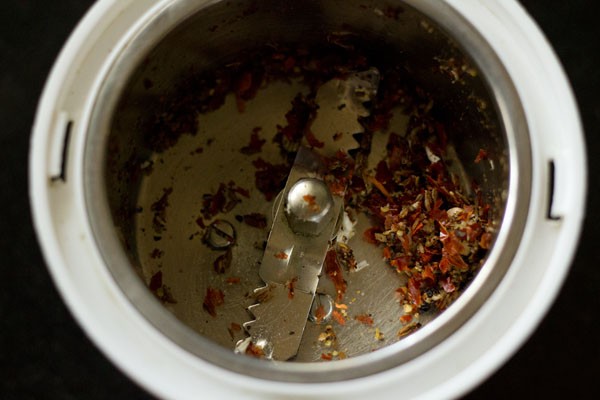
5. Crush lightly 8 to 10 medium garlic cloves with or without peels in a mortar-pestle.
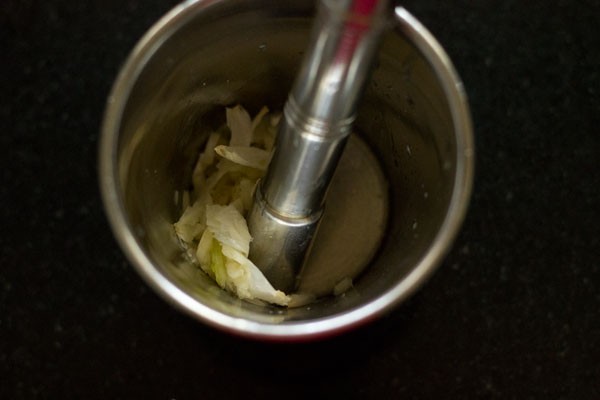
Make Garlic Rasam
6. Heat 1 tablespoon sesame oil (gingelly oil) in a pan or pot. Add ½ teaspoon mustard seeds and ½ teaspoon urad dal.
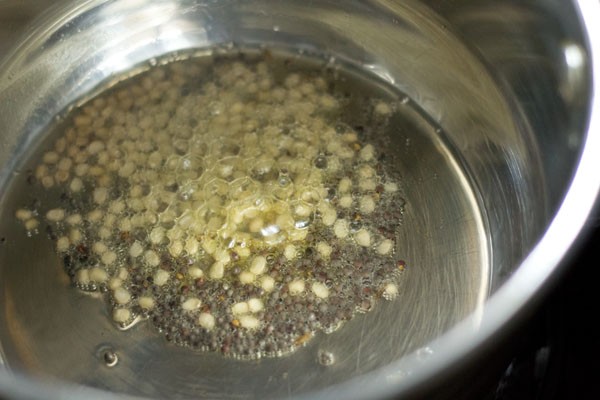
7. Sauté on low heat till the mustard seeds crackle and the urad dal turns to a maroonish color.
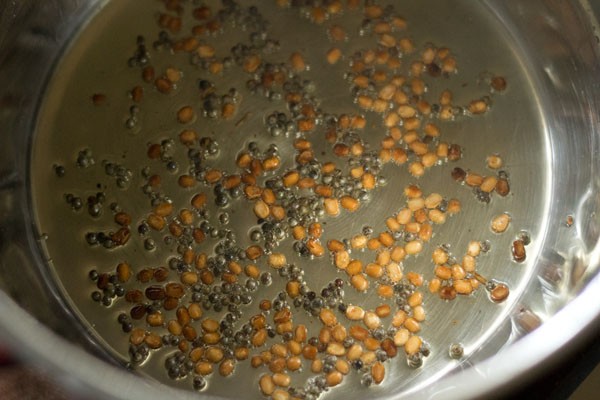
8. Then, add 8 to 10 curry leaves, 1 to 2 dried red chilies and the crushed garlic.
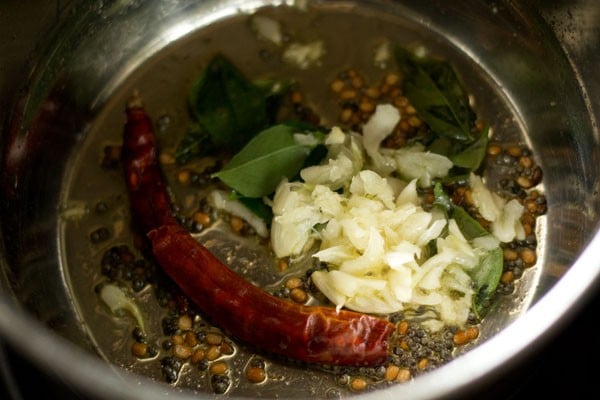
9. On low heat sauté till the garlic turns light brown.
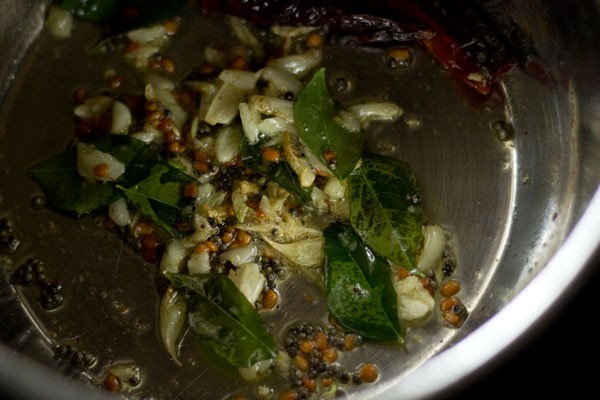
10. Then, add 1 small to medium chopped or crushed tomato, ¼ teaspoon turmeric powder and a pinch of asafoetida (hing).
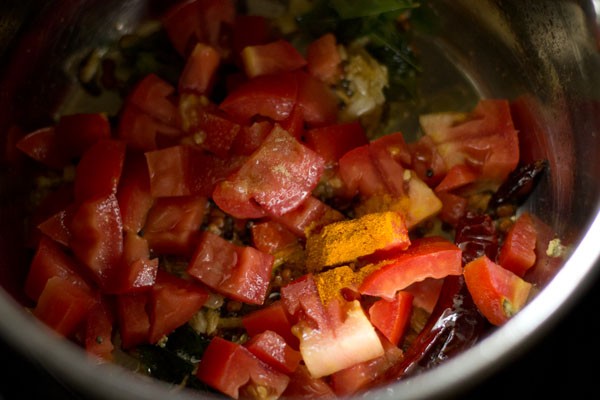
11. Stir and sauté till the tomatoes soften on medium-low heat.
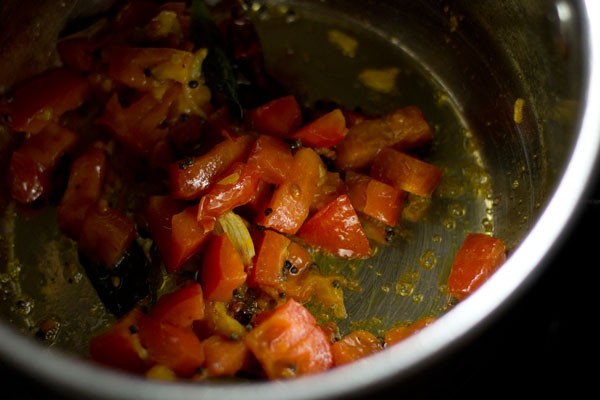
12. Add the prepared rasam spice mixture, stir very well and sauté on low heat for a minute.
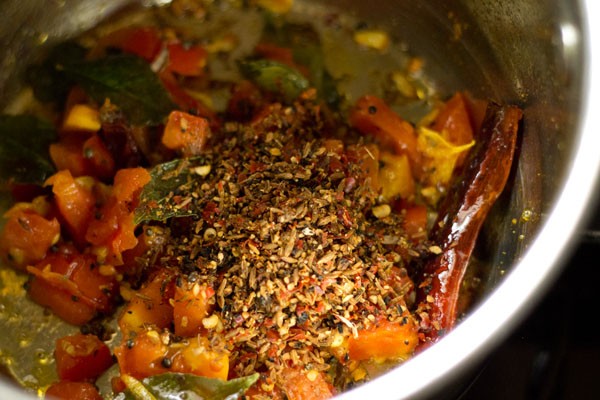
13. Now, add the prepared tamarind pulp and 1.5 to 2 cups water. Season with salt. While adding tamarind pulp, directly strain it with a tea strainer in the pan.
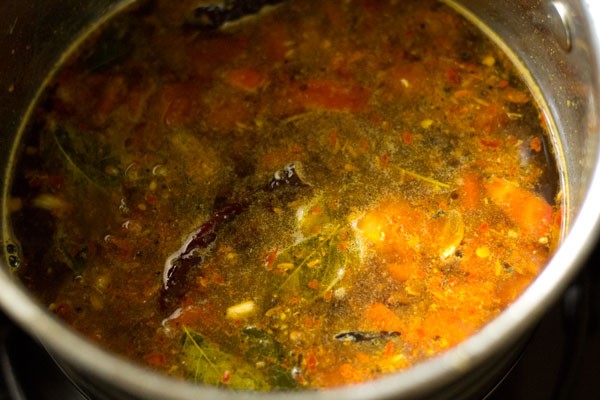
14. On medium heat, simmer the Garlic Rasam for 5 to 6 minutes.
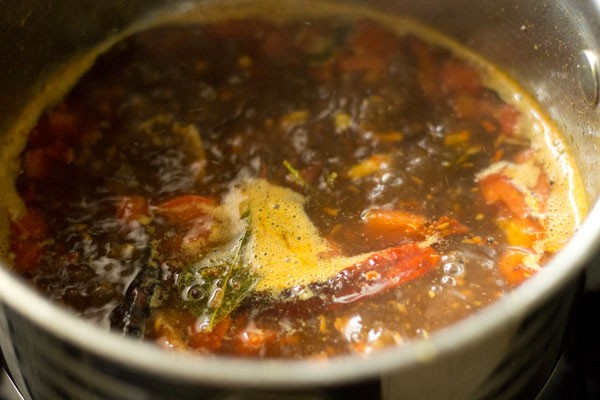
15. When done, switch off the heat and add 1 to 2 tablespoons chopped coriander leaves.
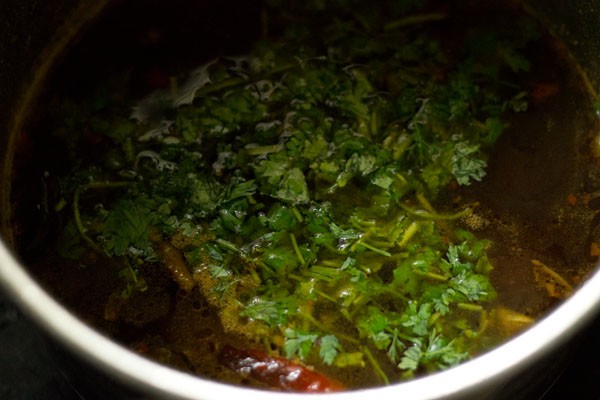
16. Serve Garlic Rasam hot with some steamed rice. You can also drink it like a soup.
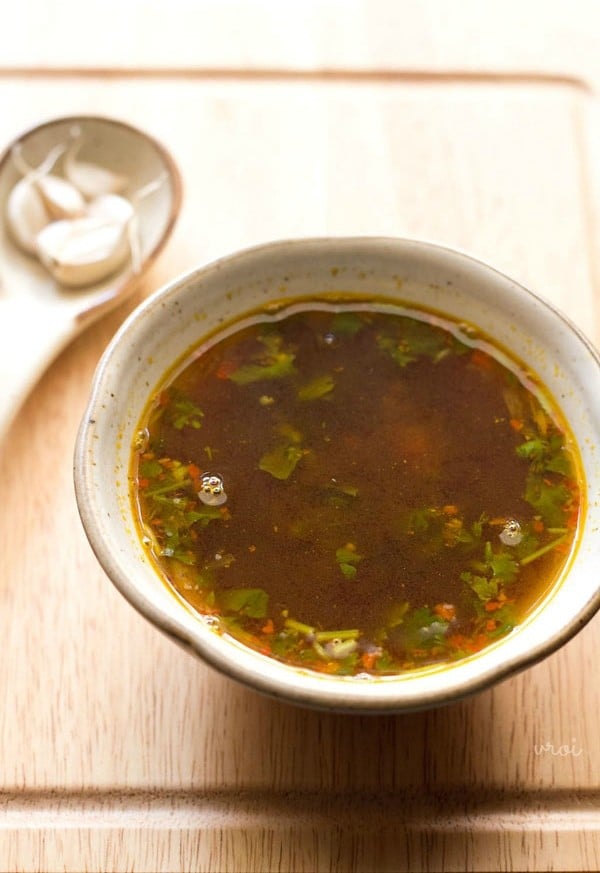
Expert Tips
- Use seedless tamarind to make the tamarind pulp. You can reduce the quantity of tamarind pulp for a less sour taste in the rasam.
- If the tamarind has some impurities, make sure to strain it first and then use the extract.
- You can use sesame oil, peanut oil, sunflower oil or any other neutral flavored oil in this recipe.
- If you are ok with a non-vegan variety of rasam, you can even use ghee (clarified butter) for the tempering.
- You can make a gluten free version of this rasam by skipping the asafoetida or using a gluten free asafoetida instead.
- Adding some chopped coriander leaves in this rasam brings in an extra freshness. However, if you wish to skip adding it, you can do that too.
More Rasam Recipes To Try!
South Indian Food Recipes
South Indian Food Recipes
South Indian Food Recipes
South Indian Food Recipes
If you’ve tried this recipe, please rate it in the recipe card or leave a comment below – I’d love to hear your feedback. For more vegetarian inspiration, sign up for my email updates or follow me on Instagram, Youtube, Facebook, Pinterest or X.
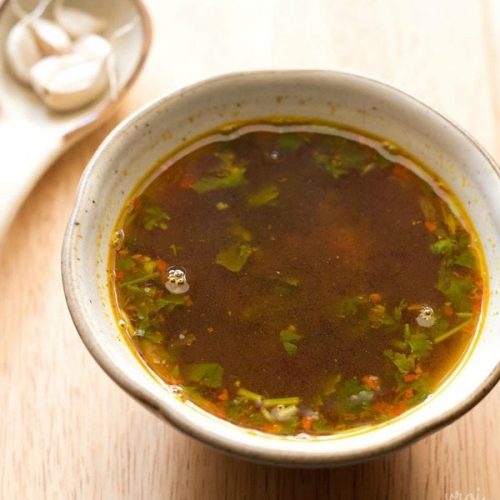
Garlic Rasam | Poondu Rasam
Ingredients
For coarsely ground rasam spice mixture
- 1 teaspoon black pepper
- 1 teaspoon cumin seeds
- 2 to 3 garlic cloves – peeled
- 2 dry red chilies – broken and deseeded
For tamarind pulp
- ½ cup water
- 1 tablespoon tamarind – tightly packed and seedless
For tempering and other ingredients
- 1 tablespoon sesame oil (gingelly oil) or preferred neutral oil
- ½ teaspoon mustard seeds
- ½ teaspoon urad dal (husked and split black gram)
- 8 to 10 curry leaves
- 1 to 2 dry red chilies
- 8 to 10 garlic – crushed lightly, with or without peels
- 1 tomato – small to medium-sized, chopped or crushed
- ¼ teaspoon turmeric powder
- 1 pinch asafoetida (hing)
- 1.5 to 2 cups water
- salt as required
- 1 to 2 tablespoons coriander leaves – chopped
Instructions
Preparing tamarind pulp
- Heat ½ cup water and soak 1 tablespoon tightly packed seedless tamarind in it. Cover and keep aside for 20 minutes.
- After 20 minutes, squeeze the softened tamarind very well in the water. Keep this tamaraind pulp aside.
Preparing ground rasam spice mix and prepping
- When the tamarind is soaking, make the ground rasam spice mix. Add black pepper, cumin seeds, peeled garlic cloves and dry red chilies (broken and deseeded) in a small dry grinder or spice grinder.
- Grind to a coarse mixture. Keep aside.
- Crush lightly 8 to 10 garlic with or without peels in a mortar-pestle. Chop or crush the tomato.
Seasoning and making garlic rasam
- Heat 1 tablespoon sesame oil in a pan or pot. Keep heat to a low. Add the mustard seeds and urad dal.
- Sauté till the mustard seeds crackle and the urad dal turns to a maroonish color. Sauté on a low heat.
- Then add 8 to 10 curry leaves, 1 to 2 dry red chilies and the crushed garlic.
- Sauté till the garlic turns light brown on low heat.
- Then add the tomato (chopped or crushed). Also add turmeric powder and a pinch of asafoetida.
- Stir and sauté on medium-low heat till the tomatoes soften.
- Add the prepared ground rasam spice mix. Stir very well and sauté for a minute on a low heat.
- Now add the prepared tamarind pulp and 1.5 to 2 cups water. Season with salt according to taste.
- On a medium heat, simmer the rasam for 5 to 6 minutes. While adding tamarind pulp, directly strain it with a tea strainer in the pan.
- When done, switch off the heat and add chopped coriander leaves.
- Serve Garlic Rasam hot with some steamed rice. You can also drink it as a soup.
Notes
- You can also opt to add less amounts of garlic if you prefer.
- Tomato can be given a skip.
- You can decrease the tangy taste, by adding less tamarind.
Nutrition Info (Approximate Values)
This Garlic Rasam recipe from the archives, first published in August 2015 has been updated and republished on January 2023.
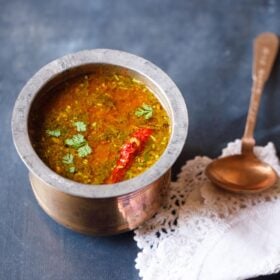
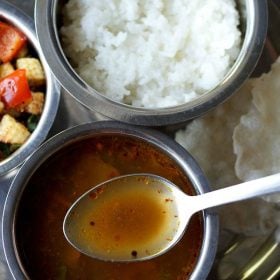
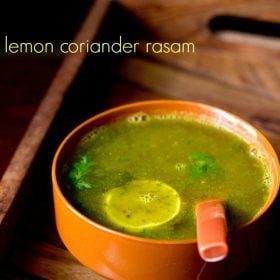
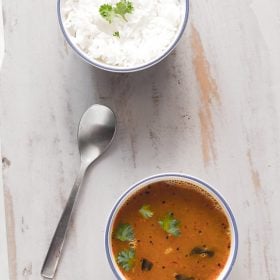

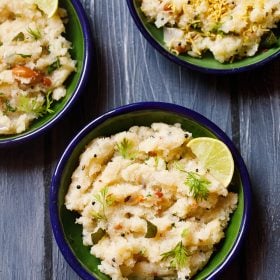
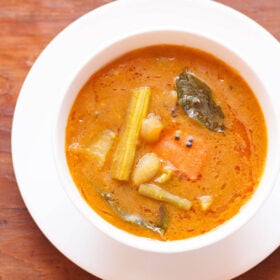
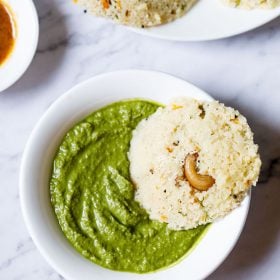








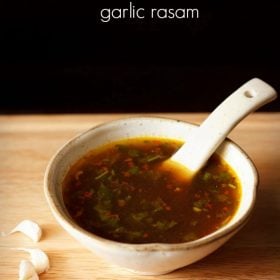
I prepared this ..it’s simply delicious..thank u
thank you deepti for this feedback and the rating too. happy cooking.
This rasam was superb dear.. everybody liked at my home.. Thank you:)
welcome divya and thank you for your positive feedback.
Awesome rasam dassana. It’s really awesome. Once in a week I eat rice that too only brown rice. And I don’t like brown rice with sambhar. But today when I prepared this rasam and brown rice with papad omg what a combination . Hmmm loved it. Thanks dassana for the amazing rasam.
welcome priya and thankyou for your positive feedback, we love rasam too with rice and papad 🙂
Hello Dassana Amit. Tried garlic rasam. It came out very good. Thanks for upload.
All the best.
thanks for the positive feedback arul.
hii m sakina…i really love ur recipes and i tried the garlic rasam..it was very easy but i dint get red chillies in my area so i used green chillies and roasted them and then put it in the food processor…it was very spicy for me so i put a lil more tarmarind and added a bit of sugar…it was tastng like indo-chinese manchurian soup…..it was very yummy…i also tried ur besan laddoo,and malai ladoo…it was superlicious…and ur recipes are soo good n easy…thankyou
thankyou sakina for trying so many dishes and for altering them 🙂 glad you liked them.
Hello ma’m thank you for your wonderful recipe.. This one is really awesome in taste… I m north Indian and as per I know RASAM is south indian dish… and from now I m gonna cook this regularly in my home… this is really very delicious… 🙂
glad to know sanjana you liked the garlic rasam recipe 🙂 and thankyou.
Your’s recipes are just awesome…Easy to made..i have improved my cooking by dis site only…thanku ao much…for helping us…
welcome pooja. nice to know this.
must try this.
Very authentic recipe! As a regular (silent!) reader of your site, I was very curious to see your take on my go-to-comfort food. And pleased that you stayed true to the andhra flavours 🙂
Only thing I do differently is crush all the aromatics in the mortar pestle and hand break chillies and add them all into the hot oil. I also omit tomatoes when I’m feeling lazy 😛 Although urad dal is new to me. We use it for all other andhra tempering except rasam.
On a different note, I love your page. I’ve tried so many of your recipes and have enjoyed making all of them.
thanks meghana. i make this rasam like this only. i didn’t know that it was andhra style. also thanks for sharing your tips.
I follow your blog very regularly.
In this recipe it would have been easier to follow if the tomatoes were mentioned in the list of ingredients as well.
Thanks
Kind regards
UKS
thanks. i forgot to add tomato in the ingredient list. have added now.
For coarsely ground rasam powder by mistake u wrote 2-3garlic cloves/lavang instead of writing cloves/lavang. Sorry i just wanted to let u knw abt it.
thanks riya for letting me know. it is garlic.